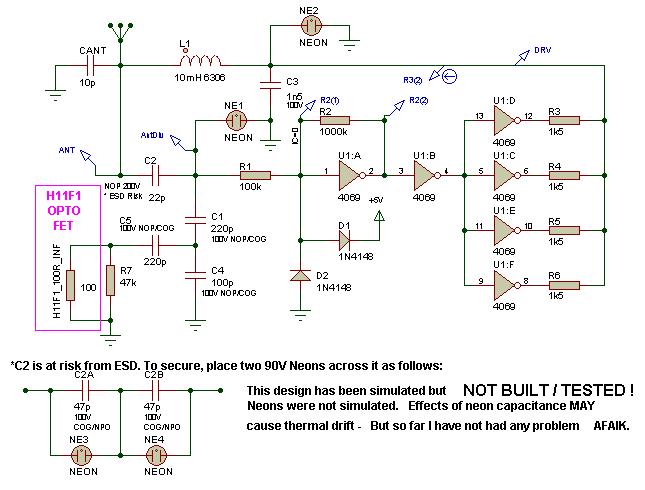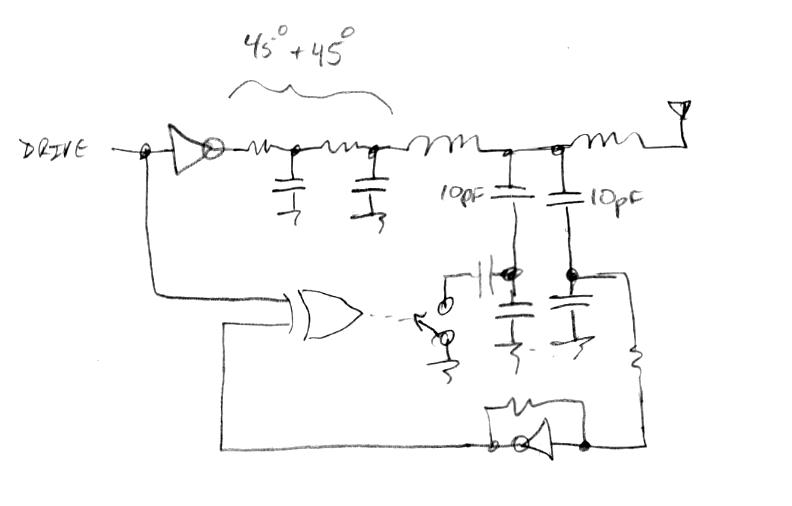"Have you tried simulating using a 10mH inductor in series with the antenna? That should give you more sensitivity, and would restrict the highest voltages to just the antenna." - Dewster
No, I havent - One of the big attractions to your oscillator was its simplicity (before you added the extra inductor, LOL ;-) - As soon as one gets to having two resonators, I fear rhat things start to get "peculiar" - the "peculiarity" can be useful for linearization or for moving the sensitive point to the antenna, or for amplification of sensitivity - But these all come with a high price tag.. One has two sets of resonators to calculate, and their actions on each other are far from simple.. I will probably stay with parallel LC tank with series LC antenna, or with the Lev topology, if I want to go this route - at least I have some idea about how to get the best component selections for these..
80V P-P to 160V P-P is a big enough antenna amplitude to overcome problems I have had with low voltage antennas.
This oscillator is for a strange "new" topology I am devising.. I will be locking the antenna oscillator (osc A) to a Xtal clock, using it in a PLL (which is why CV frequency control is needed) so that the antenna (and other antennas including volume antenna in a multi-antenna system, or for multiple theremins all synced to the same clock - even a polyphonic theremin if such a thing was playable, which I doubt! ;-) will always be radiating a fixed constant frequency.. and as such, any antennas or synced theremins will not interfere with each other.
The error signal from the PLL will be a CV out which can be tailored / shaped / scaled to taste, and can drive a HF VCO (like the diagram above) to provide a variable output frequency proportional (or at least related - shape etc modified to correct linearity, range/span, register etc) to the players hand capacitance..
On a basic theremin, one would have a constant frequency variable oscillator "inside" A PLL connected to the antenna, and a voltage variable frequency 'reference' oscillator driven by the (modified) PLL error voltage.. So one ends up with two oscillations that can be heterodyned in the usual way.
Sensitivity is no real issue - I can amplify or attenuate the error CV as much as I want, so having user adjustable sensitivity (as in, a knob to set how many octaves are available in given 60cm) and likewise, linearity is no real issue - shaping the CV will allow user to adjust linearity to suit them.. I have played with this idea on some prototypes, but the new "upside down" topology looks like I can make it all a LOT simpler.
Its actually aspiring to be a wee bit more convoluted than the above, because I intend (eventually) to turn the error voltage into a voltage giving 1V/Octave change on the output and other HF oscillators behaving correctly in response to this CV..
But I will start with a simple theremin ;-) - or at least something theremin related - I think I may well leave "real" theremins to others - but the same circuits could be used in all.. May well just do a single board people can connect to whatever they want..
Fred.
ps .. I realise this is OT, as what I am talking about is all analogue, not digital - But the core AFE oscillator, even though I am not using it at all like you are, actually looks like quite an elegant way to implement an analogue theremin IF one has a means of correcting sensitivity and linearity..
I would have real problems doing these corrections on the RF side (just as there are real difficulties correcting for linearity and sensitivity on the RF side of all theremin front-ends) with your oscillator topology - it would mean going back to double resonator stuff..
But, I think the common ground between your approach and my latest escapade, is that with both, the front end performance (in terms of sensitivity and linearity) is not critical, as these can be corrected from the derived data.
*Re: H11F1 tuning..
Suitable only for oscillators which can tolerate a capacitively coupled resistive load (and resulting loss of Q) at the antenna or a capacitance dependent frequency determining node, and where resulting (inevitable) variation of amplitude at this node (and if applicable, any related nodes) is acceptable. Beware that the voltage across the FET never exceeds its rating - I would not allow more than 20V across it, its rated at 30V.
I have used a portion of Dewsters capacitive divider and split the ground-side capacitor into 2 capacitors, (C1 and C4) to reduce the amplitude of the signal coupling via C5.. Capacitance seen 'by' the antenna is determined by series capacitance of C2-C1-C4 with an aditional series RC (C5-R7||FET) in parallel with C4 - It is the changing of the value of the R in this RC which facilitates tuning - at a price!
This scheme is probably not suitable for many usual theremin applications - it can be used on theremins with low antenna voltages by having only a series capacitor to the FET, but the incurred losses (reduction of an already low voltage) makes this an extremely poor option. When in its most significant operational mode (resistance lower than 50k, where tuning is most effective - or in the case of my circuit where a 47k is in parallel with it, resistance is limited to 47k- adding a parallel resistor helps to linearise the response of the FET) it effectively dissipates energy, so loading the antenna resistively (as in, the energy is lost, rather than recovered on the next 1/2 cycle).. this loading of the oscillator affects the amplitude and reduces effective Q - but for my applications I am often not particularly bothered by that..
http://www.fairchildsemi.com/ds/H1/H11F1M.pdf
I have also used reverse-biased opto transistors as varicaps, being controlled by the LED, but they are less predictable - althoug I have had some good results from dual isolators with their emitters connected together and using the collectors as capacitor terminals.. Unfortunately there is absolutely no data available for parts used in this way, and therefore no security regarding use of this in a product. If anyone knows of any dual transistor opto isolators which have base connections to both transistors, please advise me! - These would be a lot more useful!



